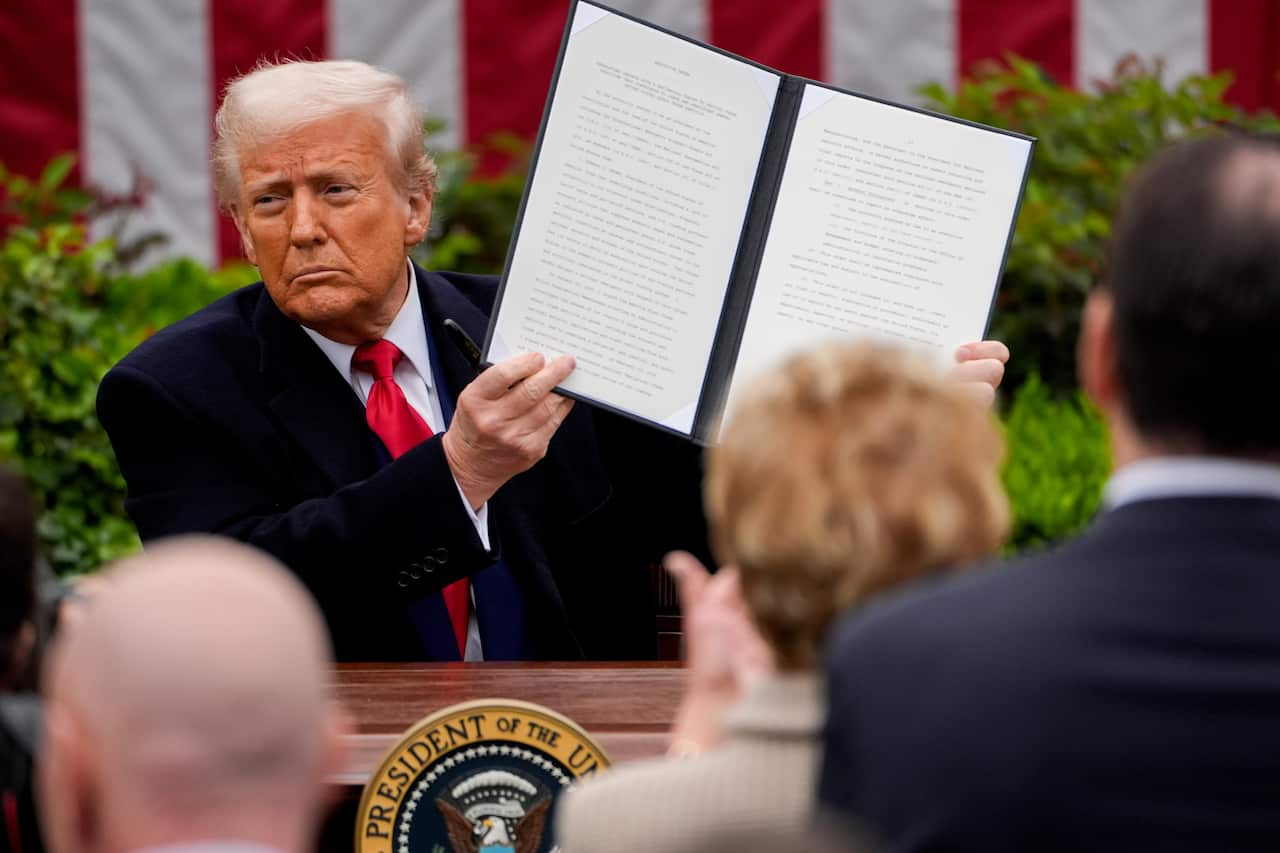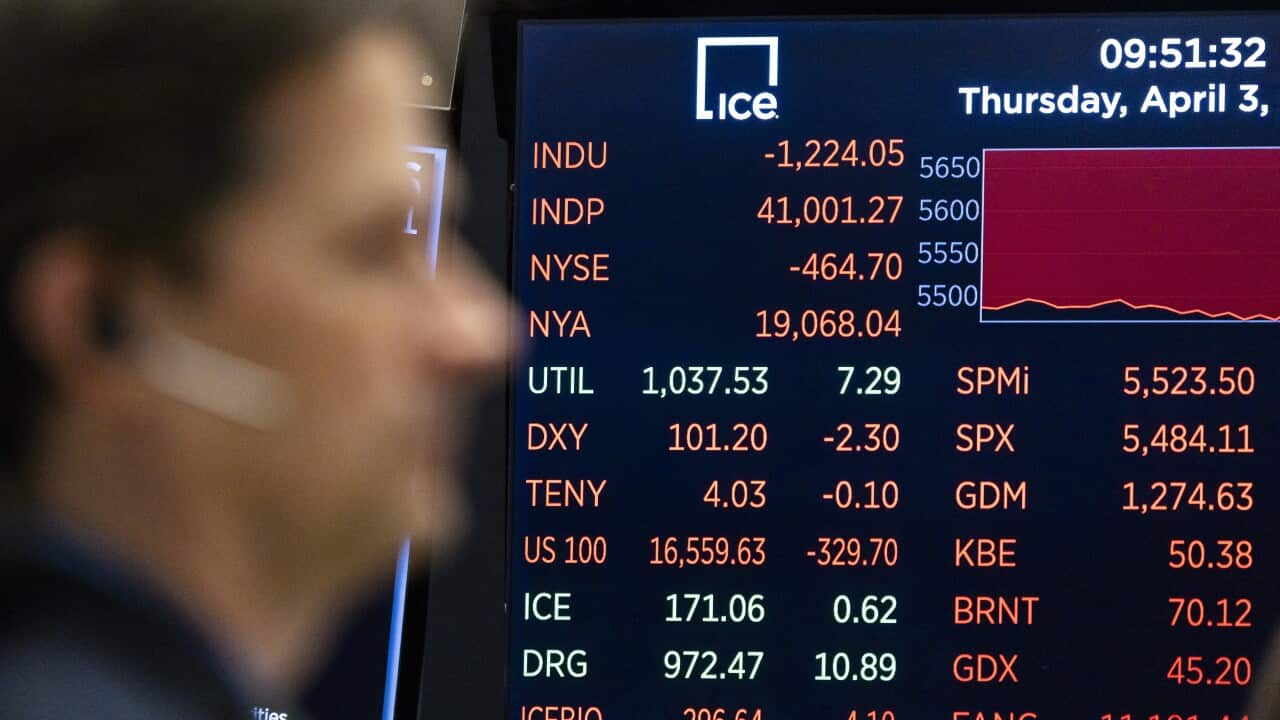Stock markets have slumped as US President Donald Trump’s sweeping tariffs ignited fears of an all-out trade war and a global economic recession.
The Australian share market has fallen to an eight-month low, with more than $97 billion wiped from its top 500 stocks in two days.
The S&P/ASX200 sank 191.9 points, or 2.44 per cent, to 7,667.8 on Friday, while the broader All Ordinaries tanked 205.1 points, or 2.55 per cent, to 7,847.6.
“Horrendous. Horrendous is the way we’ve ended up today,” IG Markets analyst Tony Sycamore told AAP.
“It’s an absolute bloodbath out there.”
“The concerns around China seem to be coming really to the surface now.”
More than $97 billion was wiped from the top-500’s $2.8 trillion market cap since Thursday, after Trump’s ‘Liberation Day’ tariff announcement came in more hawkish than expected.
Trump announced a 10 per cent tariff on most US imports and much higher levies on dozens of other countries.
Friday’s downturn followed a brutal Wall Street session, which erased an eye-watering $US2.4 trillion ($A3.8 trillion) from the S&P500. The United States Dow Jones index has dropped more than 1,680 points — nearly 4 per cent.
To make matters worse, it was confirmed the reciprocal tariffs would be lumped on top of existing import taxes, which in many cases were already extended in recent weeks.
“We’re talking about a 64 per cent tariff rate on China, on an economy which is struggling. It hasn’t been in the best shape since the COVID days and lockdown, and they’re our largest trading partner,” Sycamore said.
Markets are keenly watching for China’s next move, which could involve retaliatory tariffs and potentially lead to a tit-for-tat global trade war.
The tariffs, poised to disrupt the global trade order, highlight a stark shift from just a few months ago when the promise of business-friendly policies under the Trump administration propelled US stocks to record highs.
Investors sold positions to reflect the new economic reality, with concerns about how other countries would react to Trump’s Rose Garden declarations.
China vowed retaliation, as did the European Union, which faces a 20 per cent duty. South Korea, Mexico, India and several other trading partners said they would hold off for now as they seek concessions before the targeted tariffs take effect on 9 April.
The coming days are expected to be volatile as events unfold and the full effect of Trump’s economic actions start to feed through into the wider economy. The CBOE Volatility index, known as Wall Street’s fear gauge, touched a three-week high.
Steven DeSanctis, small and mid-cap strategist at a US-based financial services company Jefferies Financial Group, said: “There are still a lot more questions than answers out here.”
According to preliminary data, the S&P 500 lost 275.05 points to end at 5,395.92 points, while the Nasdaq Composite dropped 1,053.60 points to 16,547.45. The Dow Jones Industrial Average fell 1,682.61 points to 40,542.71.
High-flying technology stocks suffered big declines after pushing Wall Street to record highs in recent years.
Apple sank, reeling from an aggregate 54 per cent tariff on China, the base for much of the iPhone maker’s manufacturing. Nvidia slumped, as did Amazon.com.
US stocks have lost ground since Trump took office in January, with the S&P 500 and the Nasdaq dropping 10 per cent from record highs last month, marking a correction as investors priced in the economic damage from the tariffs.
Retailers were hit hard, with Nike and Ralph Lauren falling on a raft of new tariffs on major production hubs, including Vietnam, Indonesia and China.
US President Donald Trump has outlined his tariff plans at an event he called ‘Liberation Day’. Source: AAP / Kent Nishimura / POOL / EPA
Big banks such as Citigroup and Bank of America, which are sensitive to economic risks, fell, as did JPMorgan Chase & Co.
The US small-cap Russell 2000 index tumbled, underscoring concerns about the health of the domestic economy.
“Small-cap companies tend to be suppliers to the large-cap companies, so as things go bad for the large-cap names because of tariffs, they are going to put a lot of pressure on their small-cap suppliers,” DeSanctis said.
Exxon Mobil and Chevron fell, as crude prices slumped 6.8 per cent on the tariffs and OPEC+ speeding up output hikes.
The consumer staples sector was one of the few bright spots. The sector is traditionally considered a defensive play, but it was also buoyed on Thursday by Lamb Weston, which gained after reporting earnings.
Trump’s tariff’s and interest rates
Traders are ramping up expectations for the US Federal Reserve to cut interest rates four times this year, starting with a 0.25 per cent cut in June.
George Bory, chief investment strategist for the fixed income team at asset management firm Allspring Global Investments, said: “The Fed does have considerable firepower to help the market.”
“The market is now pricing in more rate cuts, and perhaps sooner,” he said, adding an easing in June now seemed guaranteed, with the chance of a cut in May as well.
Trump’s move could also see the Reserve Bank of Australia deliver more mortgage relief sooner.
ANZ Bank — until recently the most hawkish of the big four banks — on Friday upped its interest rate cut predictions due to the carnage US President Donald Trump’s tariffs are expected to inflict on the global economy.
After previously predicting just one more rate cut, the bank’s economists now believe the RBA will deliver three more 25-basis point cuts by August.
That would bring the cash rate down to 3.35 per cent, saving the average mortgage holder an additional $269 a month in repayments.
For the latest from SBS News, and .

